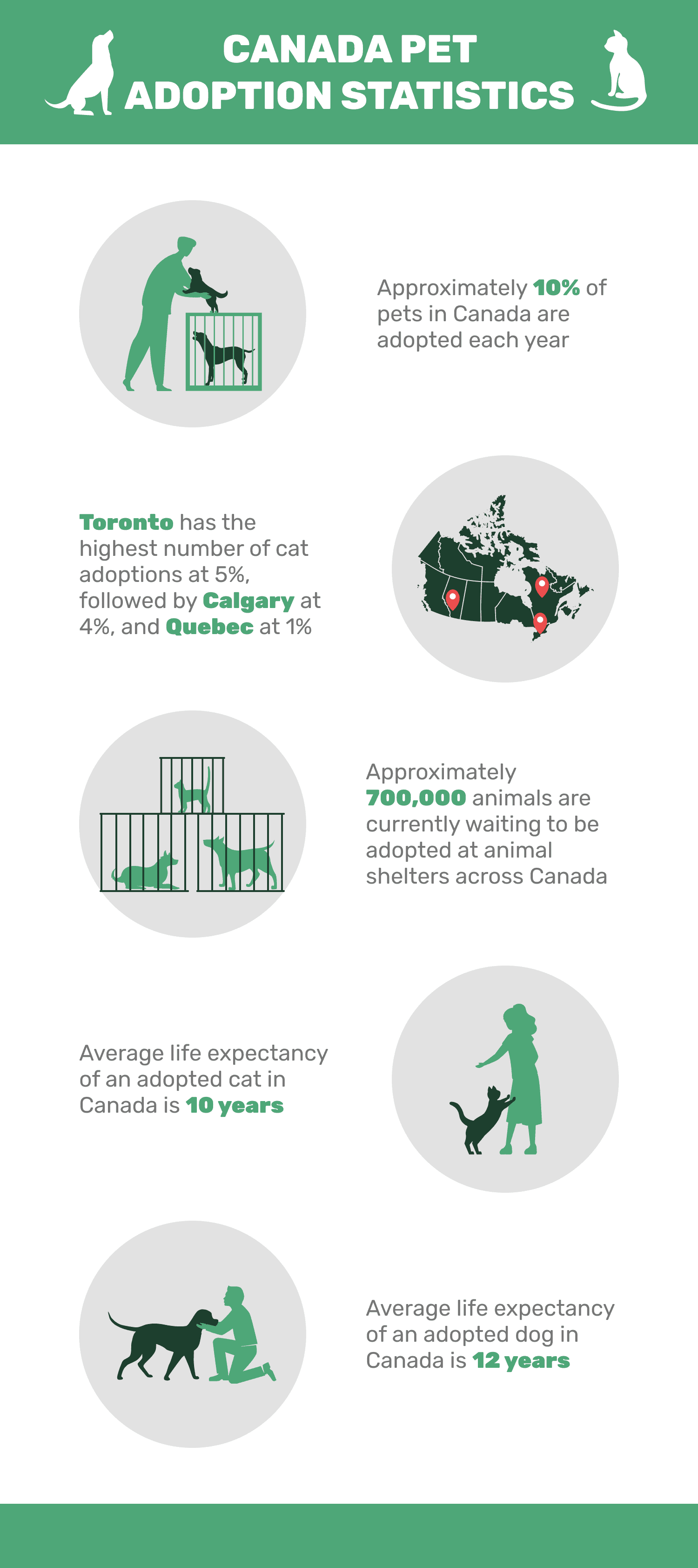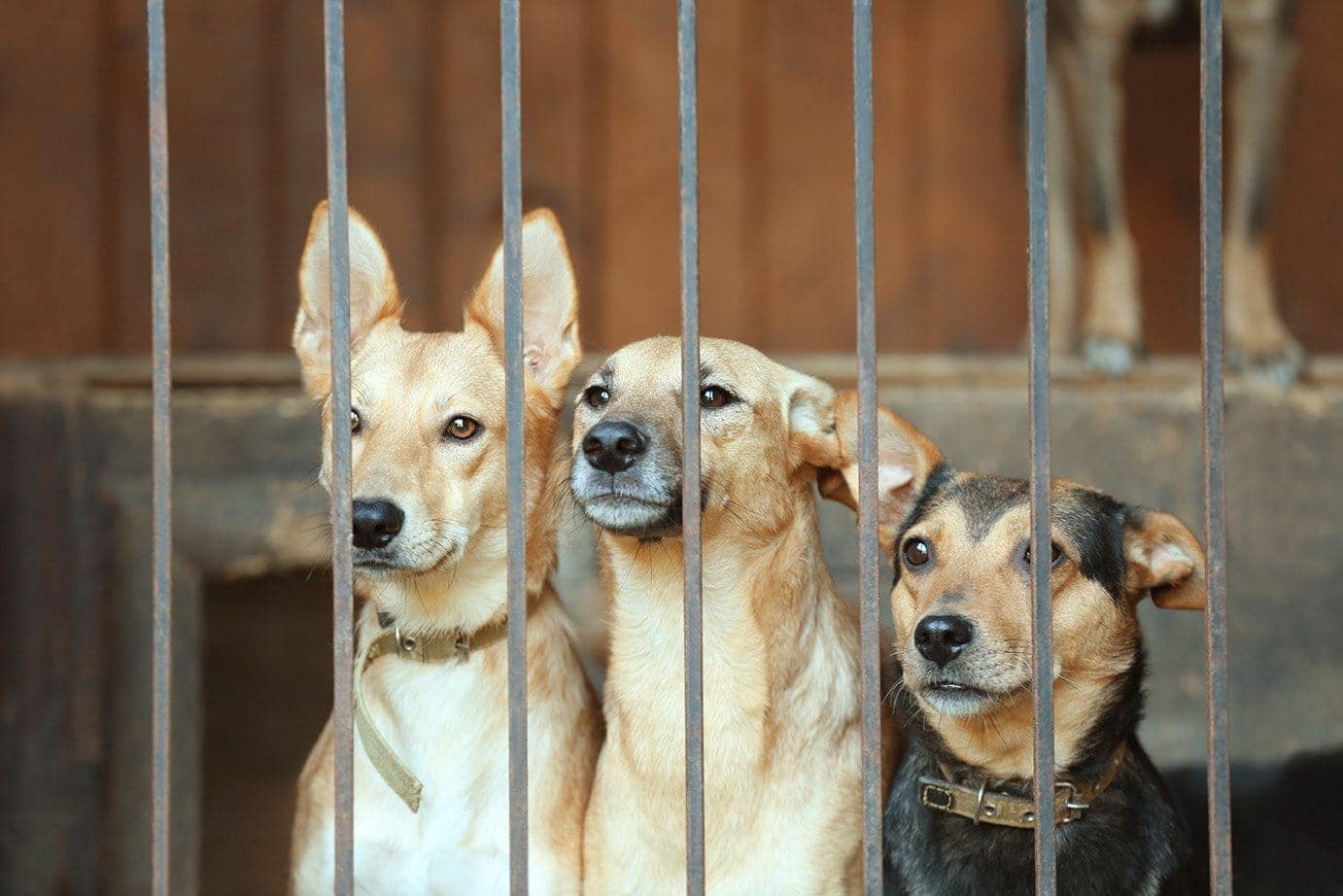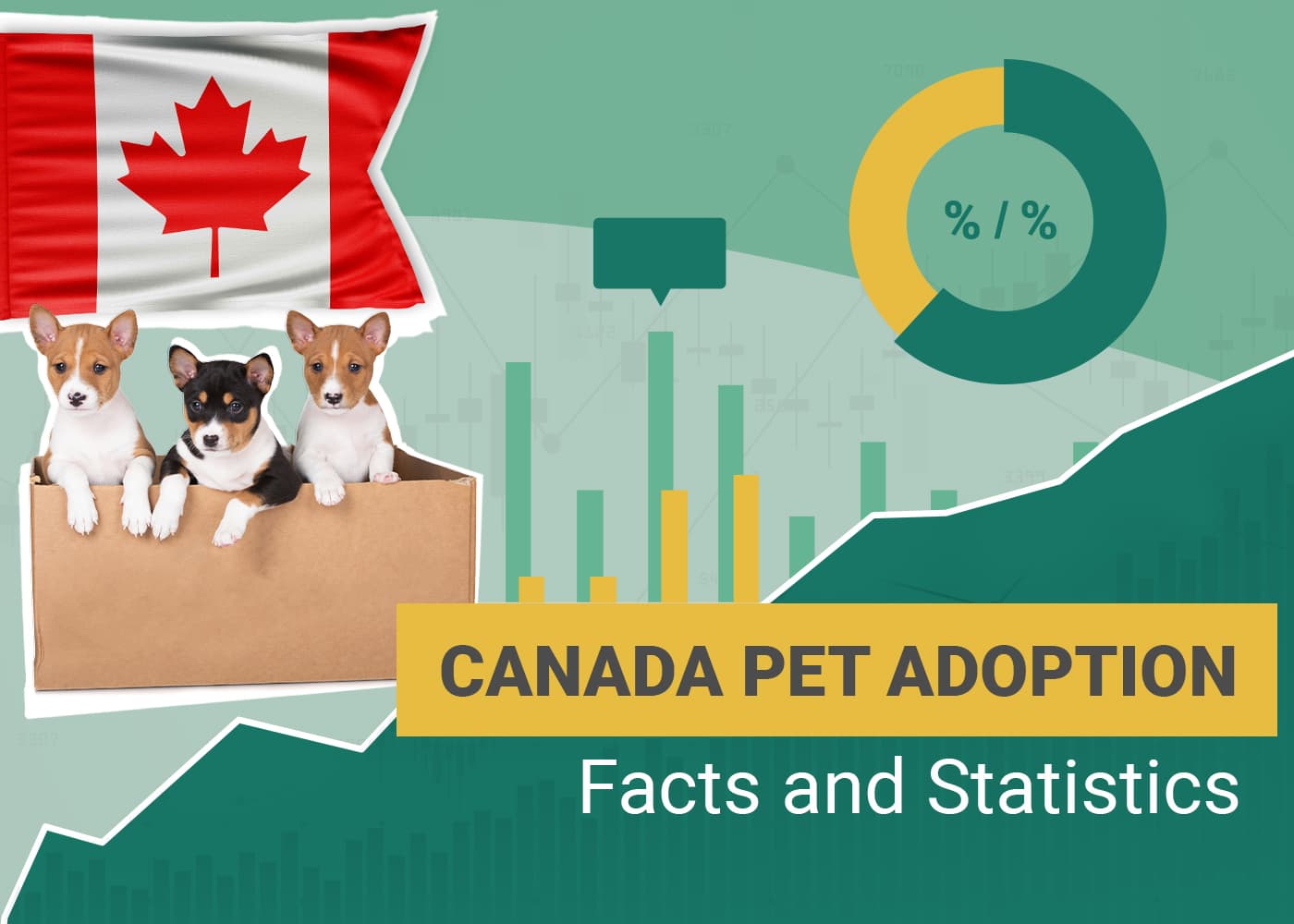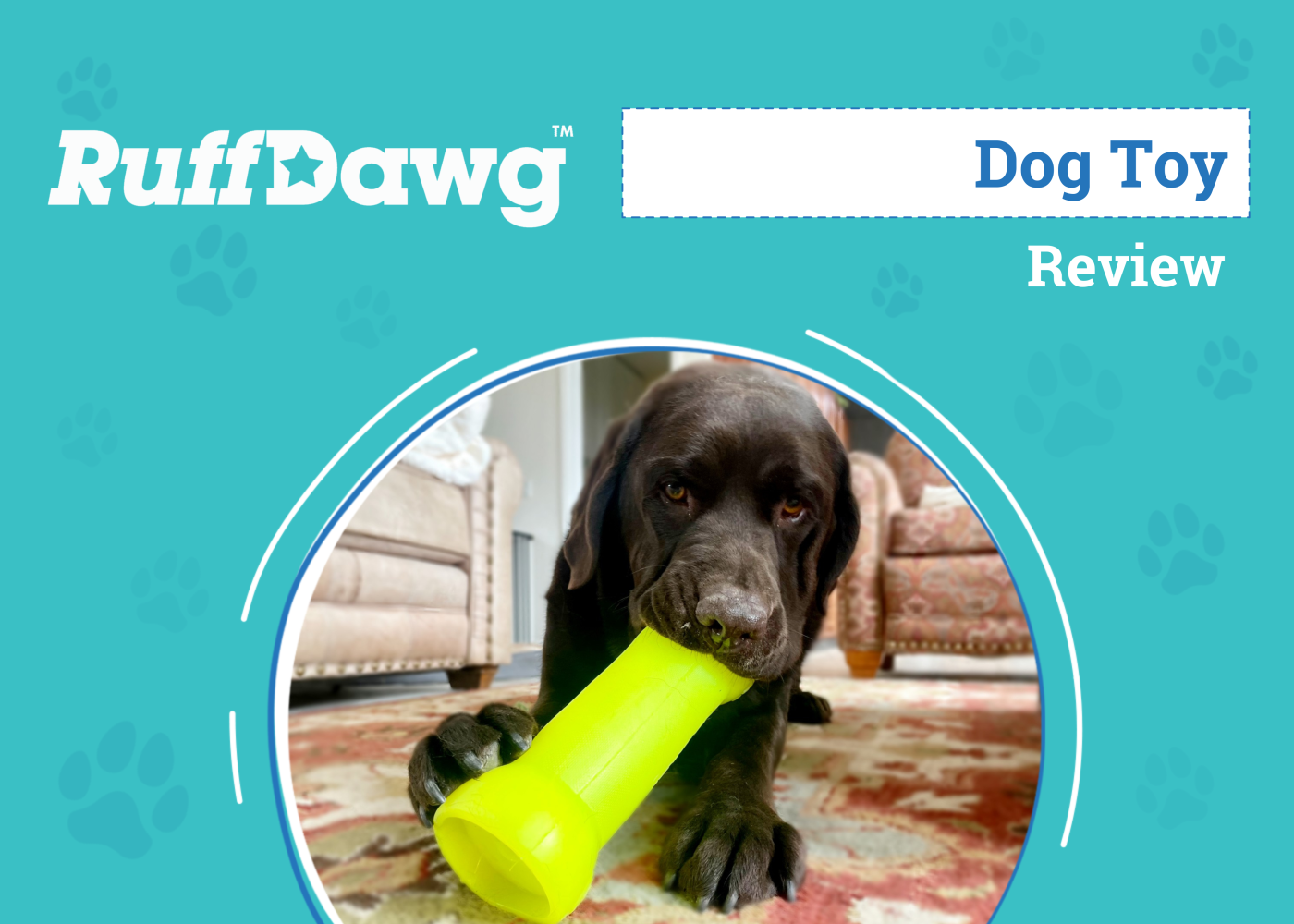Click to Skip Ahead
Note: This article’s statistics come from third-party sources and do not represent the opinions of this website.
It’s a simple fact that animals have a positive effect on human health and happiness. After all, people usually adopt a pet when they feel down. Pets are the best form of unconditional love that anyone can get.
Therefore, it’s not surprising that there are many animal adoption organizations in Canada, including animal shelters, rescue centers, and SPCAs. They’re scattered across the country with thousands of animals available for adoption at any time.
If you’re looking to adopt a cat, dog, horse, bird, or any other animal in Canada, we have compiled useful animal adoption facts and statistics to keep you informed.
The 10 Canada Animal Adoption Statistics
- One out of three adopted animals come from animal shelters.
- Approximately 10% of pets in Canada are adopted each year.
- Toronto has the highest number of cat adoptions at 5%, followed by Calgary at 4%. One percent of total cat adoptions are in Quebec.
- More than 3 million Canadians plan to adopt a pet in the next 12 months. It will lead to an increased demand for pets for adoption.
- Approximately 700,000 animals are currently waiting to be adopted at animal shelters across Canada.
- The pet population is growing fast because of the country’s aging population. There’s a growing trend among millennials to adopt a pet rather than buy one.
- The demand for pet adoption in Canada is on the rise while shelter deaths are on the decline.
- Six out of every seven dogs at shelters are not spayed or neutered before being adopted.
- In Canada, the average life expectancy of an adopted cat is 10 years, while that of a dog is 12 years.
- Dogs older than 5 years are unlikely to be put down as they can still be adopted into homes.

 Rate of Animal Adoption in Canada
Rate of Animal Adoption in Canada
1. One out of three adopted animals come from animal shelters.
(NCBI)
Animal shelters are the most preferred options for sourcing animals for adoption in Canada. This explains the ratio of 1:3 of pets being adopted from shelters. If you’re considering adopting a new pet, this statistic should encourage you to visit a local shelter!
Animal protection organizations operate animal shelters. They rescue, house, and rehome animals.

2. Approximately 10% of pets in Canada are adopted each year.
(HUMANE CANADA)
How many pets are adopted each year in Canada? According to the Humane Canada, there are over 7 million pets in Canada. Only about 700,000 pets are adopted each year, which translates to 10%
There are so many pets that need homes. If you think that you can provide a loving home for one of these animals, you can visit your local animal shelter in a bid to save more animals from euthanasia.
3. Toronto has the highest number of cat adoptions at 5%, followed by Calgary at 4%. One percent of total cat adoptions are in Quebec.
(HUMANE CANADA)
When you look at cat adoption statistics, the City of Toronto has the highest number of cat adoptions, accounting for over 5%. Calgary is second with 4% of all cat adoptions. In these two cities, people adopt pets from animal shelters and breeders.
In Quebec, most people adopt animals from shelters or other rescue organizations. It accounts for 1% of total cat adoptions.
Future Adoption Statistics
4. More than 3 million Canadians plan to adopt a pet in the next 12 months. It will lead to an increased demand for pets for adoption.
(CBC)
If you’re planning to adopt a pet in the next 12 months, there’s no better time to do it than now. There are more than 400 different shelter and rescue organizations in Canada.
The number of pets coming into these shelters each year is increasing, meaning there are more pets available for adoption than ever before. Note that animals up for adoption are not limited to dogs and cats. There are other animals, such as birds, guinea pigs, and other small animals.
5. Approximately 700,000 animals are currently waiting to be adopted at animal shelters across Canada.
(HUMANE CANADA)
According to Humane Canada, there are many animals that need homes. When one gets adopted, another one is taken in. Some of the animals in shelters include cats, dogs, rabbits, hamsters, guinea pigs, and other small animals.
The number of animals surrendered to shelters is a primary concern for animal welfare organizations. 700,000 is such a huge number. As a result, many animals are being euthanized because there aren’t enough resources available to care for all of them.

6. The pet population is growing fast because of the country’s aging population. There’s a growing trend among millennials to adopt a pet rather than buy one.
(OCHD)
In Canada, nearly one in three households has a pet. As people get older, their interest in acquiring a pet increases. Older adults are adopting animals to provide them with companionship and a sense of purpose.
If you look at adoption vs. breeder statistics, more animals have been adopted from shelters by older people.
7. The demand for pet adoption in Canada is on the rise while shelter deaths are on the decline.
(CANADIAN VETERINARIANS)
According to Canadian Veterinarians, hundreds of thousands of animals are killed in shelters every year. Despite this grim reality, the demand for pet adoption is on the rise.
Within the next 5 years, animal adoption may reach an all-time high in Canada. Many pet owners are choosing to adopt a pet from a shelter rather than buying from a breeder.
Condition of Adopted Animals (Age and Life Expectancy)
8. Six out of every seven dogs at shelters are not spayed or neutered before being adopted.
(NATIONAL GEOGRAPHIC)
Shelters across Canada are struggling with pet overpopulation and euthanasia rates. There’s a 70% chance that a dog will be euthanized. The reason for this high rate is that people who adopt a pet don’t consider getting their new pet spayed or neutered. In most cases, they don’t even ask about it before adopting.
The key to cutting down pet overpopulation is spaying and neutering. Studies show that if all dogs were spayed and neutered before adoption, these issues would decrease.

9. In Canada, the average life expectancy of an adopted cat is 10 years, while that of a dog is 12 years.
(III)
The life expectancy of a cat is between 12 and 14 years. It can vary depending on the breed and lifestyle of the cat and the amount of care and attention they receive. The average lifespan of a dog is 10 to 13 years. But some breeds live longer than this.
These statistics show that once you adopt a pet, you are going to live with them for a long time.
Animal shelters are overflowing with homeless animals. Millions of dogs and cats are euthanized in Canada every year. It’s due to the lack of adoption for these poor creatures.
To solve this issue, more people should opt for pet adoption. It’s a win-win situation for the owner and the adopted animal.
10. Dogs older than 5 years are unlikely to be put down as they can still be adopted into homes.
(OSLER)
Many older dogs have been trained and are ready for a new family. Besides, organizations that advocate for adopting older dogs say that most of them can have a long lifespan.
The other reason is that they are usually less expensive to adopt than puppies or young adult dogs. Also, older dogs already know basic obedience commands; training them isn’t as much of a challenge.
Adult dogs are potty trained and have fewer health problems than puppies.
Frequently Asked Questions on Canada Animal Adoption
How has the COVID-19 pandemic affected animal adoption in Canada?
(FRONTIERS)
Thousands of animals for people infected with coronavirus in Canada have been euthanized. In Toronto, animal shelters are overwhelmed with abandoned pets. The adoption of animals from shelters has slowed to a trickle. As a result, several rescue groups have stepped in to take these animals.
Although the virus does not affect animals, it has created a greater need for more rescue groups. The government has set up more shelters to hold the influx of abandoned animals. People are spending less on their pets because they are faced with tough times.
What’s the ideal age to adopt a cat and a dog?
The best age to adopt a cat is 12 weeks old. It’s because kittens need a lot of socialization in their first weeks. After 12 weeks, the window of opportunity closes. Cats often take longer than dogs to bond with their owners. But they’re usually more independent and self-sufficient than dogs. They’re less likely to get lonely when left alone for long periods.
Conversely, the best age to adopt a dog is between 7 and 9 weeks. Dogs are easier to train and can adapt to different living spaces. Also, they need less exercise than cats. About 30 minutes of walking or playing per day should do the trick. They’ll let you know when they need to go out.
That said, the adoption age for any pet should be based on your lifestyle and schedule. If you’re not active, a younger dog would be better suited to you, especially if you live in an apartment.

What is the most adopted animal in Canada?
(SPCA)
Pet adoption is on the rise. The number of animals adopted from shelters has increased by 38% over the past 10 years. It’s estimated that about 81,000 cats are adopted each year. However, this number is small compared to the total number of cats entering animal shelters in Canada each year.
When looking at the latest dog adoption statistics from SPCA, the number of dogs adopted in Canada is estimated to be around 30,000 each year. It is quite a huge number when compared to the number of dogs entering animal shelters each year. Of the 30,000 adopted dogs, approximately 30% are puppies.
According to the report from Humane Canada, the most adopted animals over the years are cats, dogs, rabbits, and guinea pigs.
Given the figures above, cats come in at number one, followed by dogs. These two pets are also the most popular in the United States. The difference between them is that Americans prefer dogs to cats, while Canadians prefer cats to dogs.
The third pet is the rabbit. It comes in many varieties that live in different climates. There are about 90 rabbit breeds all over the world.
The fourth pet is the guinea pig. It’s a small mammal of the Cavia family. The guinea pig lives on land and has many varieties that live in different climates.
What is the procedure for adopting a pet in Canada?
(Toronto Humane Society)
Adopting a pet is a humane act of showing animals kindness and giving them a second chance at life. If you’re looking at pet adoption sites, the sheer number of pets can be overwhelming. Try narrowing down the field by looking at the kind of lifestyle you have and whether a pet would fit in. You can start from shelters and rescue centers.
You will start with an application process, which includes references and interviews. The shelter or animal rescue group will discuss the adoption with you. They’ll provide more information about the pet, such as their history and personality, in a bid to ensure that the dog is a suitable fit for you and your family. You also can ask any questions that you may have about the animal’s behavior.
You can meet the potential pet at an adoption event, in a foster home, or through a visit to the animal shelter. If you’re adopting a dog or cat, it’s important that you meet with the animal’s veterinarian. The vet may want to examine your potential pet for signs of illness or injury. Also, you’ll need to make sure that you are ready for all the costs associated with owning the pet. These costs can include food, toys, training classes, grooming, insurance, license fees, and medical bills
Once you have chosen a pet and paid the adoption fee, you’ll sign the adoption agreement, and officially, you become a proud pet owner.

Do animal shelters perform background checks on people who want to adopt pets in Canada?
Yes, they do. They’ll check your neighborhood, previous landlord, and even the vet you have used.
Although it’s done to ensure that animals go to good homes, it’s also a responsible measure by the shelter to ensure that their animals are in safe hands.
What will happen if you adopt a pet and it doesn’t work out?
If you adopt a pet from an animal shelter, there is always the chance that the animal will not work out for you. So, you should understand your rights if the adoption doesn’t work out.
When an animal shelter adopts an animal out, they are not giving away the pet. They are transferring ownership of the animal to you. So, if a pet doesn’t work out, return the pet to the shelter where they came from.
How do you calm a newly adopted dog?
(PETFINDER)
In the first few weeks of bringing home a newly adopted dog, keep their life as stable as possible.
One of the best ways to reduce stress in a newly adopted dog is to create a predictable environment. You can do this by keeping to a routine for feeding, exercise, and walks. Also, you can establish a safe space for your dog inside your home.
Adopting from a shelter vs. buying from a breeder: What’s the best?
(PETS RADAR)
If you are thinking of owning a pet, you may be faced with the dilemma of either adopting or buying from a breeder. While both options are viable, they have their pros and cons. For instance, a breeder may choose not to disclose to you some underlying problem with the pet in question or any lineage problems that might affect them down the line.
Shelters don’t have that option. They must disclose all known health problems to potential adopters before releasing an animal for adoption. They will provide a comprehensive medical history of their animals. This way, you can learn about any known health problems, medications, or supplements required and other information when deciding whether to adopt a particular animal.
When buying from a breeder, one usually gets a puppy or kitten. Puppies and kittens need a lot of work until they mature. Thus, if you want to avoid the process of raising one from scratch, you can simply adopt an adult pet from a shelter. Additionally, buying from a breeder is costly compared to adopting a pet from an animal shelter.
Overall, it is fair to give shelter animals a chance at life by adopting. Remember, for each animal adopted from a shelter, several are saved from euthanasia. So, each animal’s quality of life will improve if they’re adopted. Not only will you enjoy spending your life with an animal companion, but you’ll also become an advocate for ending shelter pet overpopulation by adopting.
 Final Thoughts
Final Thoughts
There are thousands of homeless animals in shelters and rescue centers in Canada. An extensive education campaign must be launched to promote spaying, neutering, and adoption. These campaigns will help people share ideas on how they can build a more humane society.
There is hope to decrease the number of animals put down. In almost all cases, if you adopt from an animal shelter or a rescue center or consider buying from a friend or acquaintance, you’ll save the animal from euthanasia. Animal rescue is a worthwhile cause.
Featured Image Credit: Alexas_Fotos, Pixabay










